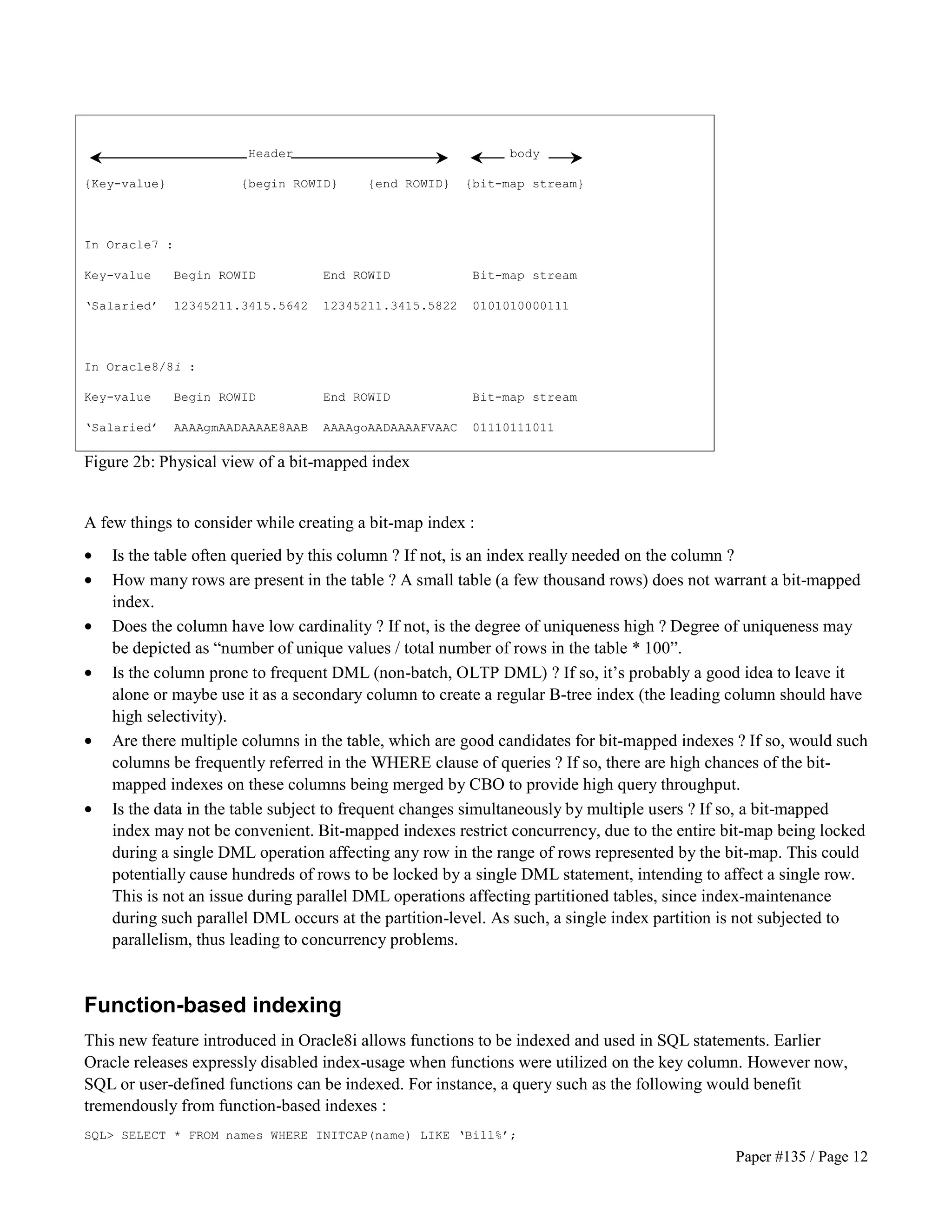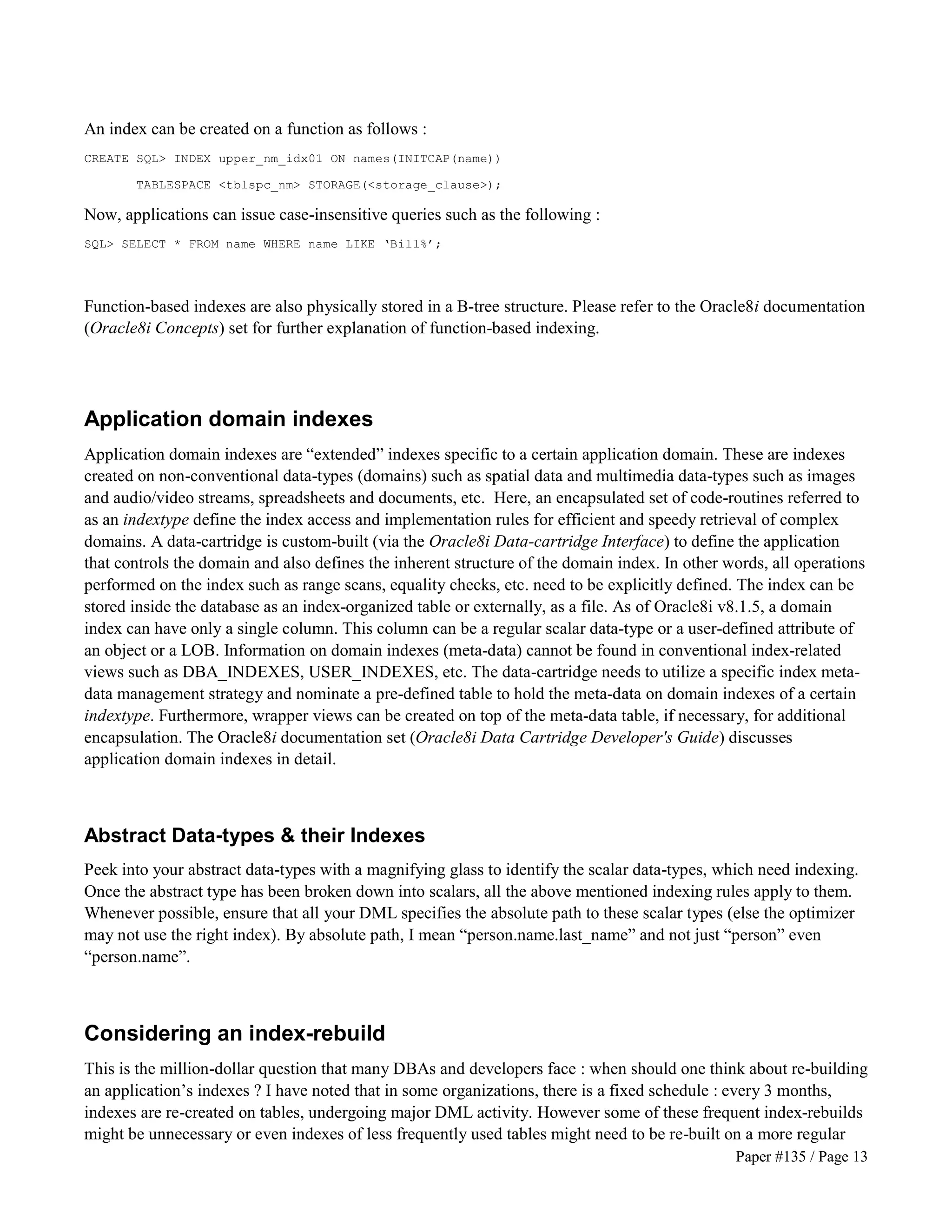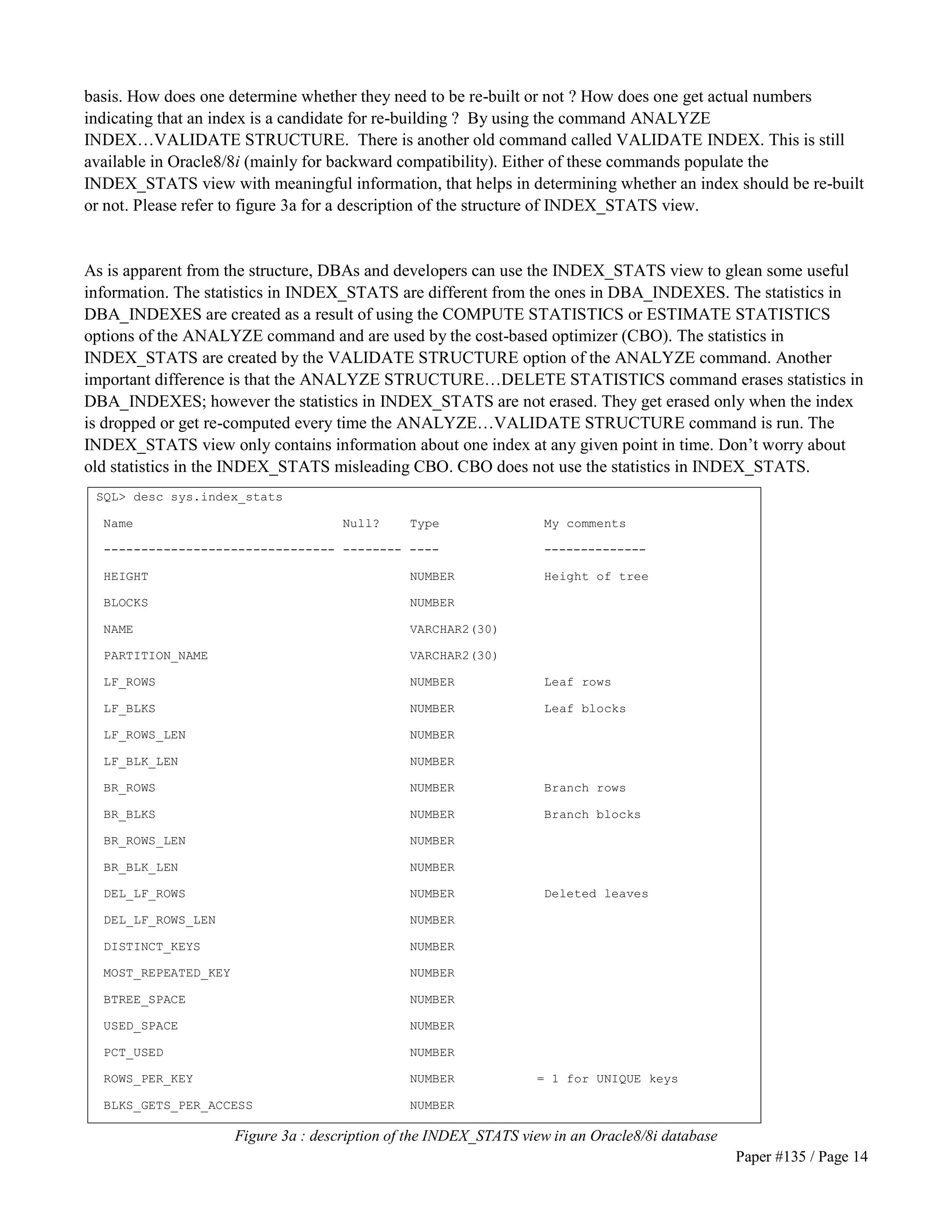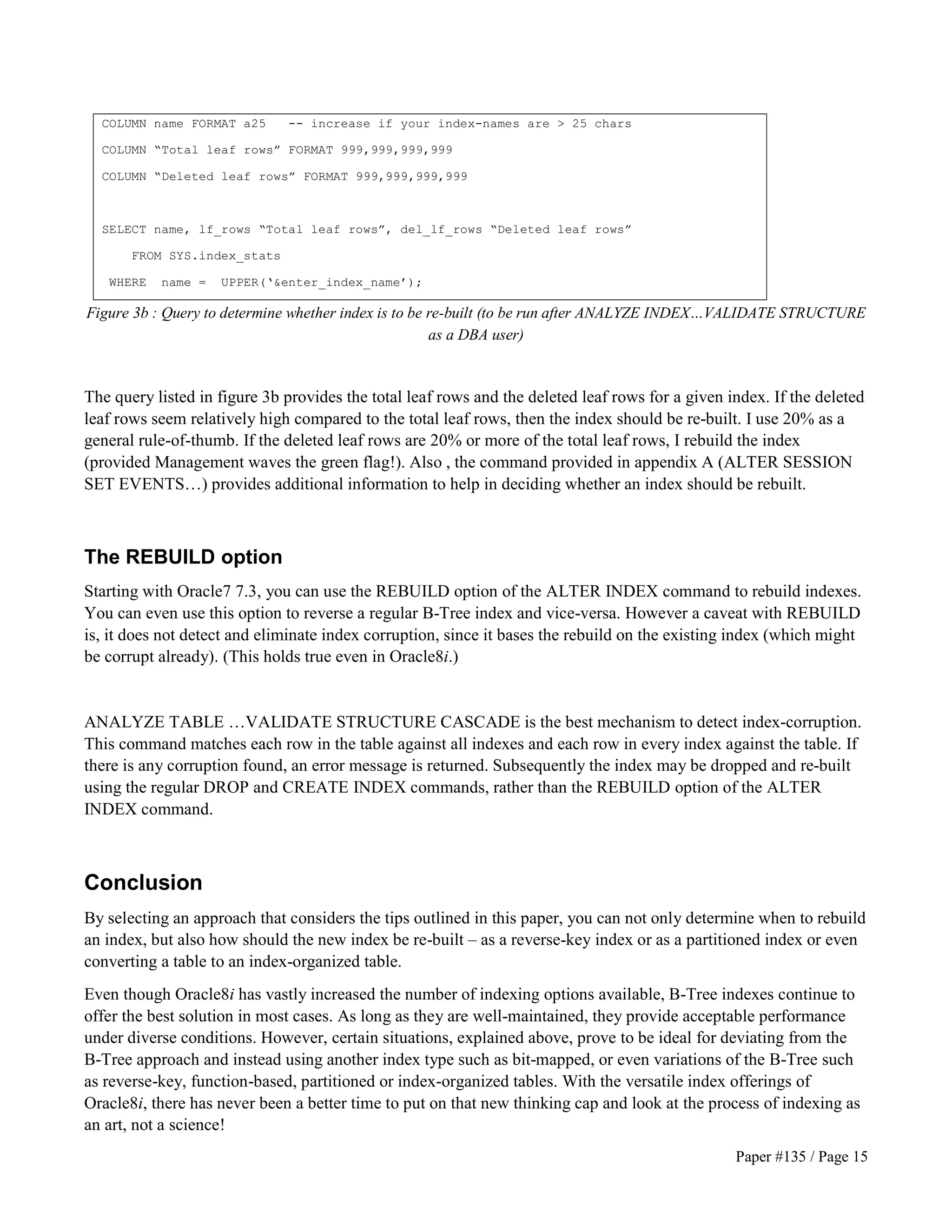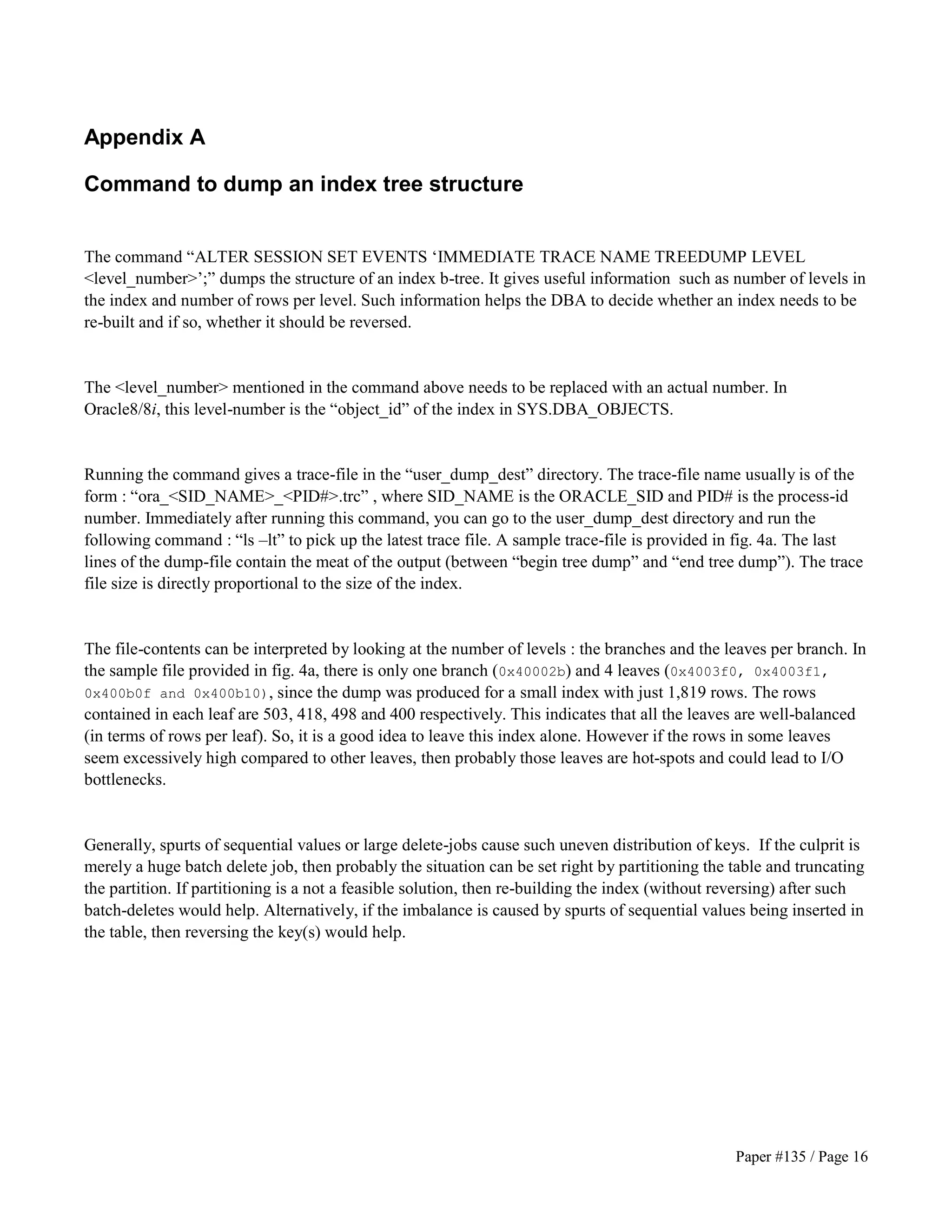This document discusses indexing in Oracle8i. It begins by introducing indexes and their importance. The objectives are to introduce the various index types and access paths available in Oracle8i and provide examples of index usage. The document then discusses the major index types including B-tree indexes and bitmap indexes. It also covers index sub-types and access paths. The remainder of the document focuses on providing details on B-tree indexes, including how they are structured and how inserts, deletes, and updates are handled.
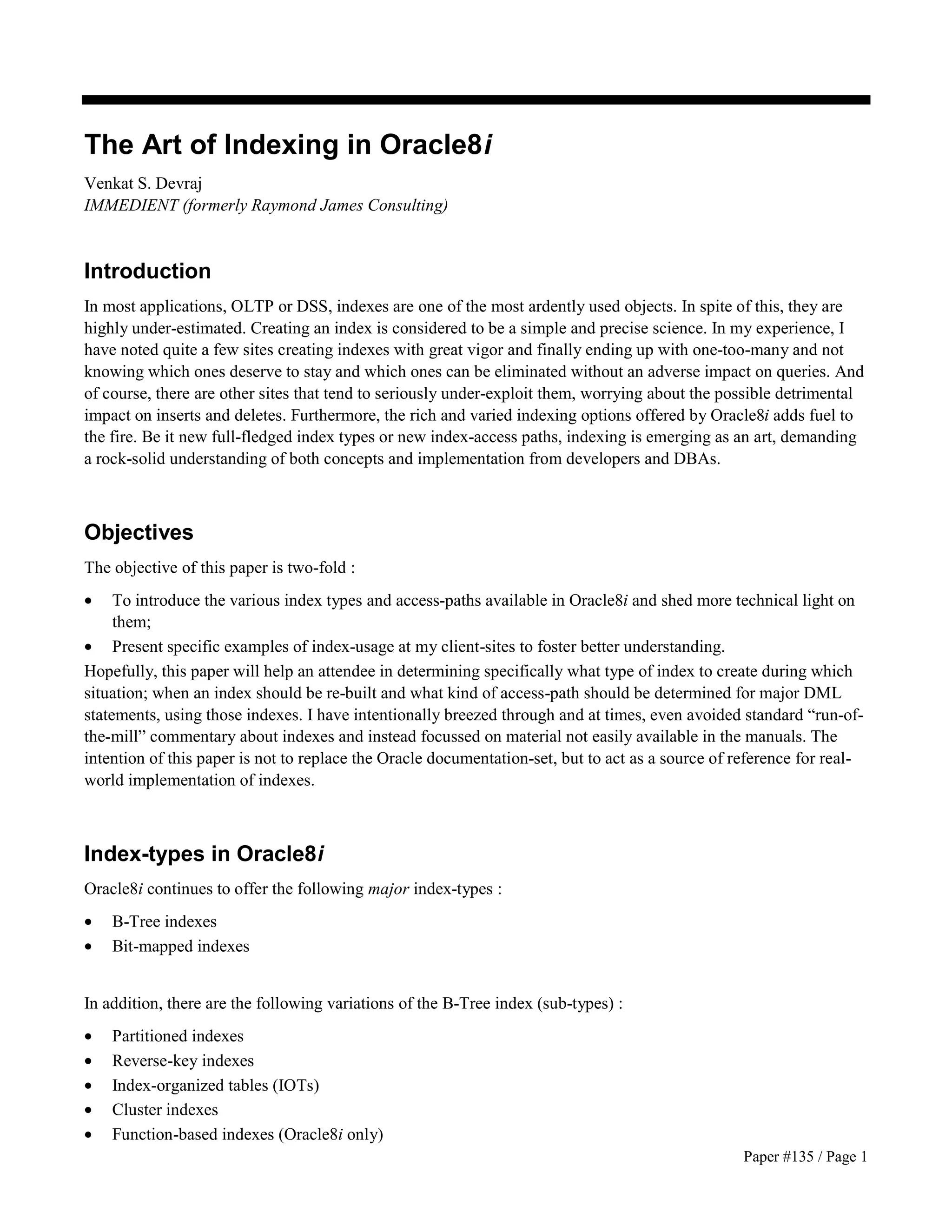

![· Usage of hints to force index-selection : Under both rule or cost based optimization, certain hints may be
provided to DML statements to specifically select a certain index. This functionality is provided to override
the optimizer, in case the access-path selected by it is sub-optimal. Syntax for hints are very similar to
comments, except for the addition of a plus (+) symbol. If a hint is provided incorrectly, the optimizer ignores
the hint.
Example : SELECT /*+ INDEX(table_a, index_a) */ id, name FROM table_a;
Index-related hints supported by Oracle8i include INDEX, INDEX_DESC, INDEX_COMBINE,
INDEX_FFS and PARALLEL_INDEX for retrieving rows from indexes in an ascending order, descending
order, combining bit-mapped indexes using boolean logic, prompting the optimizer to use the Fast Full Index
(FFI) scan in lieu of a full-table scan and inducing a parallel-scan of an index (using PQO) respectively.
B-Tree Indexes : Everybody’s most favorite index!
This is one of the earliest indexing options available in Oracle. And we are all absolutely familiar with this index-type,
right ? OK, let’s have a quick show-of-hands : how many of us here today, understand or remember a B-Tree
structure ? Believe me, good usage of these “basic” indexes requires a good understanding of how B-Trees
indexes operate. Implementation of B-Trees are a little unique in every application in terms of it’s height and
order. However, the basic behavior is the same. Let’s take a quick practical look at how B-Trees indexes have
been implemented in Oracle8.
M
G S
A B C
D E F
H I J K
L
N O P
Q R
T U V
Root/branch
nodes
Leaf nodes
Fig. 1a : A simplistic B-tree implementation (height : 2 and order : 2) [Branch/leaf nodes read to locate “R” are displayed
Paper #135 / Page 3
in bold]
B-Trees are an excellent way of looking up pointers to large information with minimal number of disk-reads. In a
B*Tree, all information is either a branch/root node or a leaf-node. The final information (ROWIDs and keys) are
always stored in a leaf (-node). Upto 16 columns can comprise the key in Oracle7.x, whereas in Oracle8.x, it is 32
columns. Furthermore, a key cannot be greater than 1/3rd the size of the database block (violating this restriction
would result in the ORA-01450 error). A leaf may contain multiple physical rows. The leaves are always present](https://image.slidesharecdn.com/artofindexingino8i-141121065108-conversion-gate01/75/Art-of-indexing_in_o8i-3-2048.jpg)

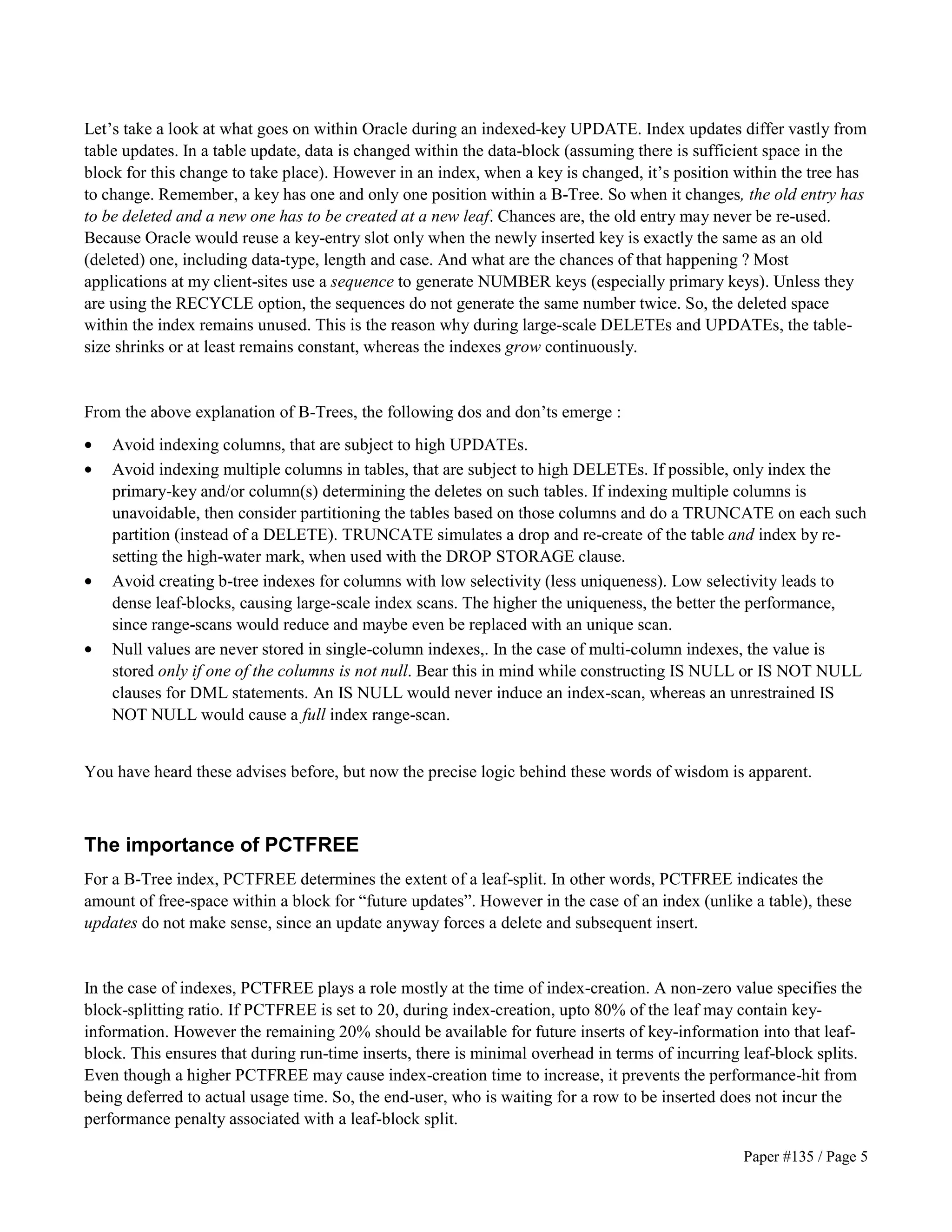
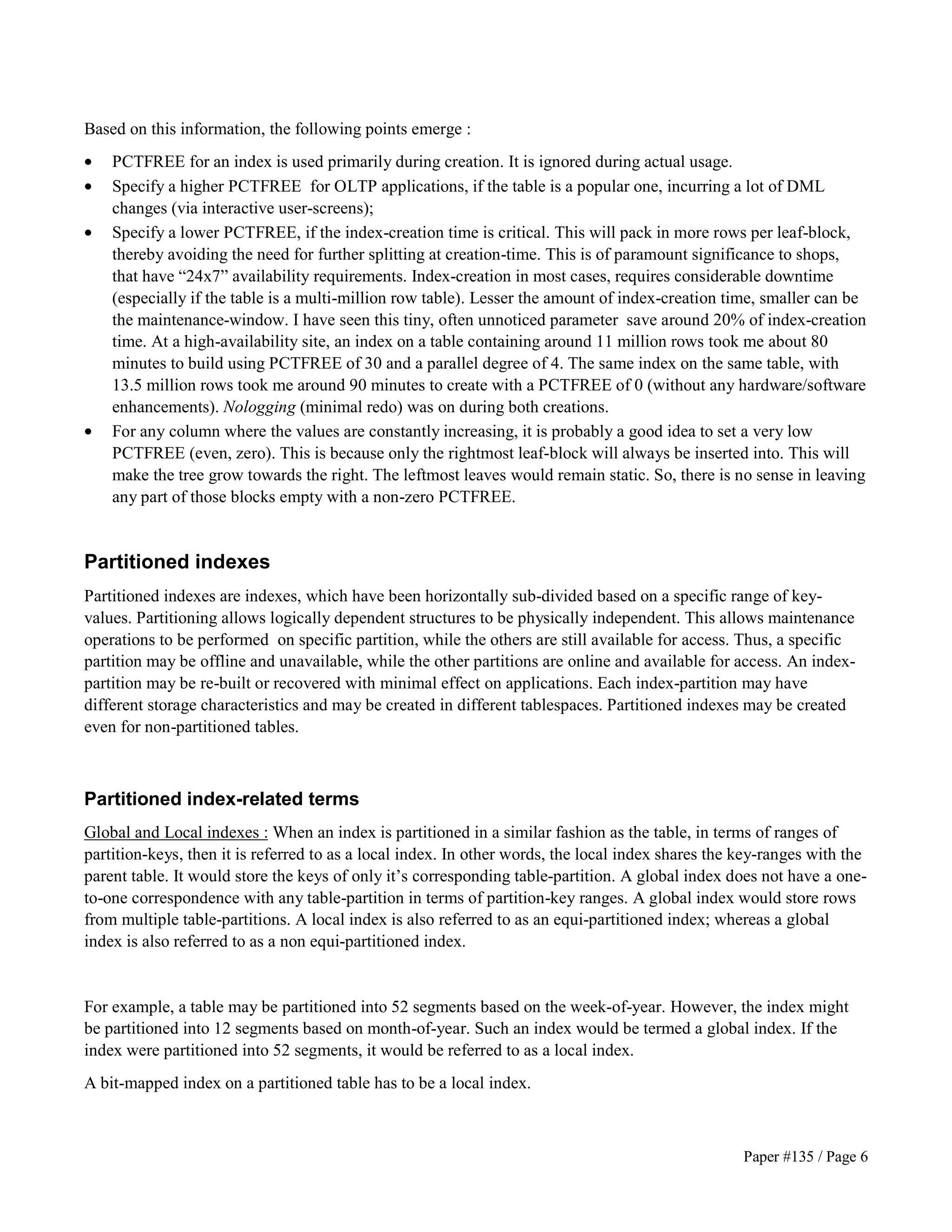
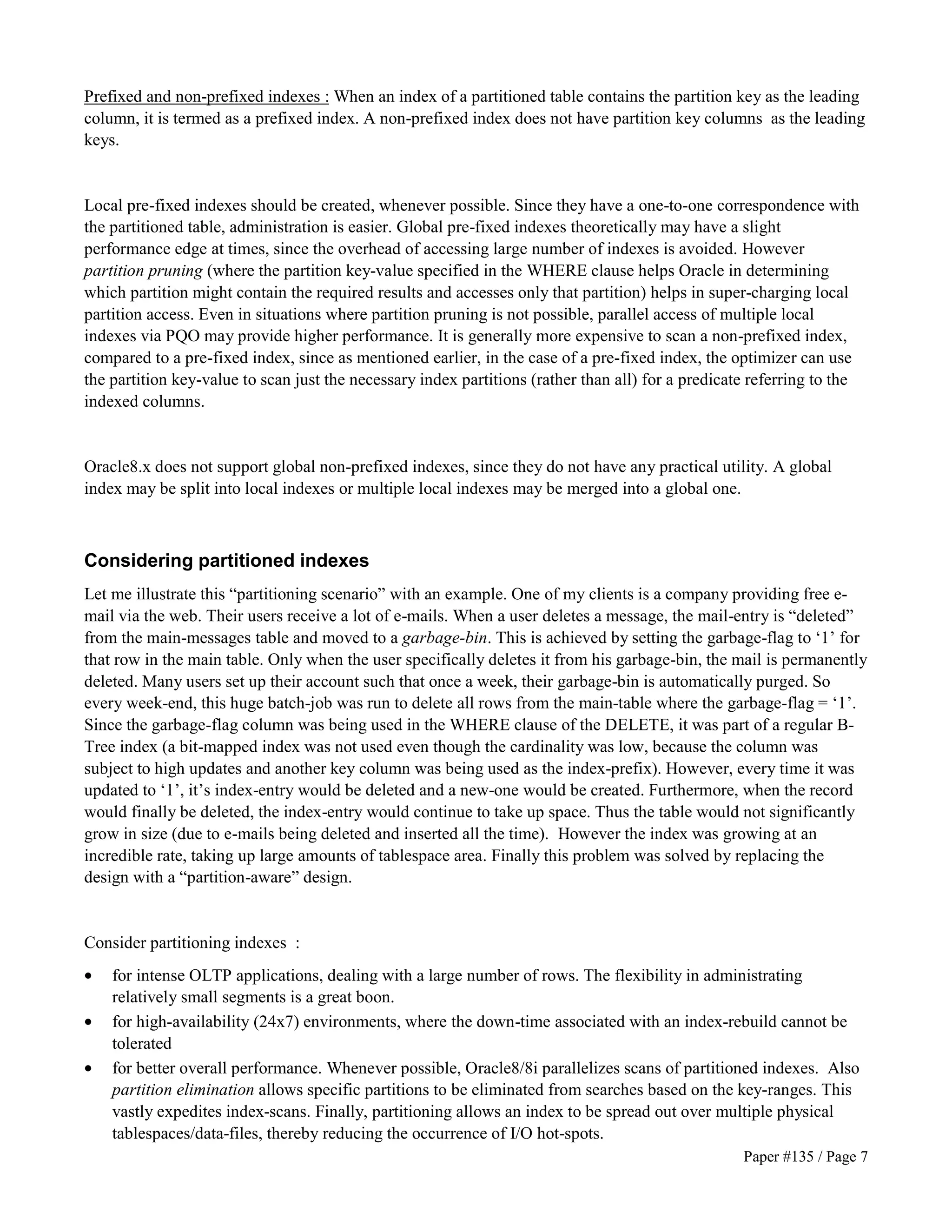
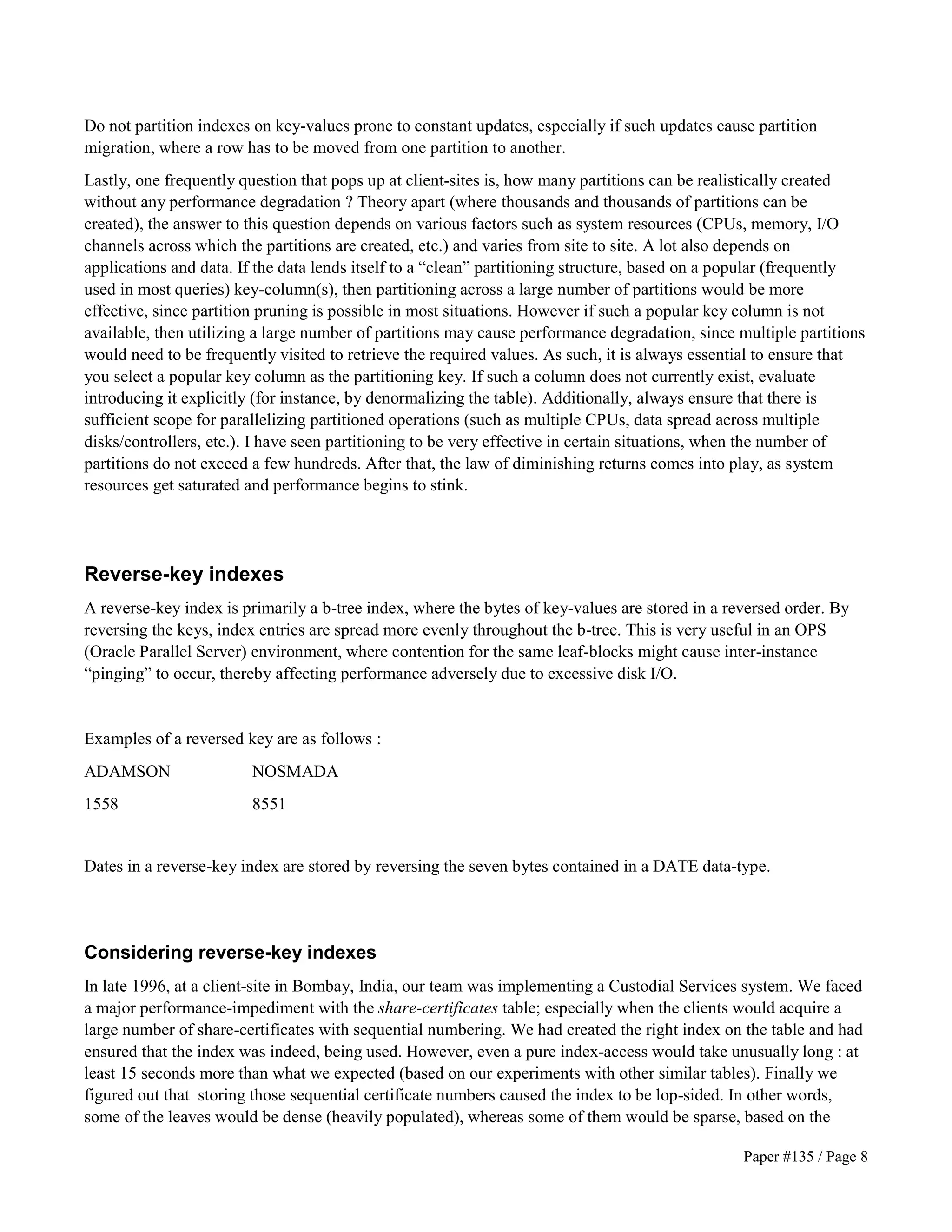
![series of share-certificates we obtained. Most DML activity would focus on these dense leaves, thereby creating
“hot-spots” on the index. By hot-spots, I mean index-activity would be much more for these few leaf-blocks,
compared to the others. Since there would usually be only one disk-controller accessing those blocks, all activity
would have to be serialized, thereby adversely affecting response-time and throughput.
In such a situation, reverse-key indexes would have been a boon. However we were using Oracle7 v7.3 at that
time, where the feature was still not available. We lived with the situation for a while. Finally, we circumvented
the situation by reversing the values within the application. We had two columns in the table, a column that would
store the share-certificate number as it was and a primary-key column, which would store the same share-certificate
in a reversed order. We wrote a stored function, which would accept the actual share-certificate as an
input parameter and return the reversed number, which would subsequently be inserted in the table as the primary
key. This gave us a relatively “well-balanced” index.
The same concept applies to any value that increases in spurts : sequential numbers, date and time columns, etc.
Increasing in spurts indicates a scenario where the value monotonously increases, then there is not much activity
for a while, thereby creating “gaps” in the values; then the value constantly increases again. Such columns would
be prime candidates for using the Oracle8/8i reverse-key indexes. Also, in fast-growing tables where indexes are
built on sequential values (such as a primary-key index), and large-scale deletes frequently occur, the index may
begin to “slide”. A sliding index is one that continuously grows towards the right (newer rows being inserted),
while the left-portion is constantly being deleted (older rows being purged). The left-portions of the tree
comprises of nulls or empty leaf-nodes, whereas the tree is expanding to the right, thus appearing to “slide”.
Reversing the index may halt the right-oriented growth (due to constantly increasing key-values) and make the
growth more balanced by placing the reversed key-values in all directions (left and right). Additionally,
partitioning the index (on a “rolling window” scheme) and truncating older partitions (rather than deleting) would
help in eliminating the large number of empty leaf-blocks.
One question might come to your mind : how did we manage to figure out that our index was indeed lop-sided ?
We used an “ALTER SESSION SET EVENTS” command to understand the index-structure better. This
command is mentioned in more detail in Appendix A.
Some caveats to bear in mind while using reverse-key indexes :
· Reverse key indexes are not effective when used in range scans
· Reverse key indexes are prone to all the restrictions of regular b-tree indexes, such as avoiding excessive
Paper #135 / Page 9
DML activity, periodic re-building, etc. (since they are merely a variation of B-Trees).
Index-organized tables (IOTs)
Index-organized tables are tables, where the rows are stored in a B-Tree structure, based on the primary-key
value. A primary key definition is mandatory for an IOT. In Oracle8 v8.0.x, IOTs do not have rowids (this
restriction is removed in 8i via “logical rowids” [explained below]). An index entry is expected to be terse to
remain effective. Since a full-fledged row may be too big to retain index-effectiveness, Oracle8/8i provides the
PCTTHRESHOLD clause to indicate a percentage of the total block-size. All non-primary key columns that cause
a row to grow beyond the size of this percentage are moved to an “overflow” tablespace.](https://image.slidesharecdn.com/artofindexingino8i-141121065108-conversion-gate01/75/Art-of-indexing_in_o8i-9-2048.jpg)

![Bit-mapped indexes
The biggest difference between a b-tree index and a bit-mapped index is that the former encourages indexing on
columns with high selectivity, whereas the latter encourages low selectivity. This is primarily due to inherent
structural differences. A bit-mapped index creates a binary bit-map stream, consisting of 1s and 0s for every
distinct key-value. It uses distinct bits (of every byte) to create these binary steams. Due to application of bit-level
binary arithmetic, large-numbers of rows can be processed at high speeds. Also, if a table has multiple low-cardinality
columns, then bit-map indexes may be created on each of those columns. Multiple indexes in turn will
be merged using bit-level boolean logic resulting in very fast index-access times. In the case of compound
indexes, a bit-mapped index can have upto a maximum of 14 columns in Oracle7.x and upto 30 columns in
Oracle8/8i (always 2 less than B*Tree indexes). Bit-mapped indexes are available only with CBO.
Bit-mapped indexes are stored in compressed form, thereby causing huge space-savings. Oracle uses a proprietary
compression algorithm, capable of handling even high-cardinality columns (this is useful in scenarios such as a
star-schema, where the dimension tables have very high cardinality). On a data-warehouse at a client-site, a B-tree
index on a column with 2 distinct values on a table with 12 million rows took up around 184Mb, whereas a bit-mapped
index on the same column now takes up a mere 3Mb – a direct saving of more than 98% disk-space!
The star-transformation access-path (introduced in Oracle8) uses bit-mapped indexes to merge results from
multiple dimension tables with a large fact table to produce extremely fast query results, without having to
perform an expensive Cartesian product as in a regular star query.
An example of a good candidate for a bit-mapped index would be the “marital status” column on the customer
table in a data-mart for the Sales department. The marital status column would have a domain consisting of the
following 4 values : single, married, divorced, widowed. The logical view of a bit-mapped index created on this
column is represented in table 2a :
Paper #135 / Page 11
'RPDLQ 9DOXH
&XVWRPHU /DVW
1DPH
6LQJOH 0DUULHG 'LYRUFHG :LGRZHG %LWPDS
SDWWHUQ
6PLWK
:KLWH
%URZQ
%ODFN
Table 2a : column “Bit-map pattern” provides the logical index-key pattern [remember a bit may either be on (1) or off (0) ]
From a physical standpoint, each bit-map stream consists of a header portion and a body, wherein the header
comprises of the key-value and the beginning and ending rowids for a range of rows having that key-value. The
body comprises of the actual bit-map stream for the same range of rows. The size of the body is guaranteed to be
50% or less of the initialization parameter DB_BLOCK_SIZE. Thus, a bitmap may be stored as smaller pieces to
adhere to this rule. The physical structure is depicted in figure 2b.](https://image.slidesharecdn.com/artofindexingino8i-141121065108-conversion-gate01/75/Art-of-indexing_in_o8i-11-2048.jpg)
